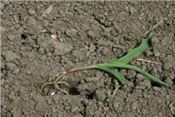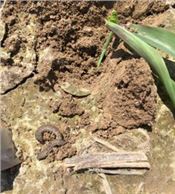Black Cutworm: Management Considerations In Corn
DR. NICK SEITER
URBANA, ILL.
With corn planting wrapping up throughout most of Illinois, the time has come to scout for cutworms. While several species of cutworms infest early season corn, black cutworm (Agrotis ipsilon) is the most likely to cause economic damage. We have received a handful of reports of cutting in southern Illinois, with more expected in the coming weeks as heat units begin to accumulate. If you are not doing so already, follow Kelly Estes’s reports on the Bulletin and through Twitter (@ILPestSurvey) for up to date information on black cutworm moth flights and degree-day accumulations. These updates provide excellent guidance on when to expect damage in your part of the state (remember that the predicted dates are a forecast, and are subject to change based on actual temperature accumulations).
A few management points to consider:
• Infestations are more likely in later planted corn, as delayed planting means larger cutworm larvae are present at earlier stages of corn development.
• Black cutworm moths prefer to lay their eggs on grasses, not bare ground. Therefore, fields with grassy weeds present at or shortly before planting are more likely to experience damaging populations. Similarly, monitor fields closely if a grass cover crop (e.g., cereal rye) is terminated while corn is susceptible to cutworm damage (emergence to ~V5).
• The economic threshold for black cutworm is 3 percent of plants cut with black cutworms still present in the field. Look for plants that look like they have been cut roughly with scissors close to the base (Fig. 1); plants with intact roots (Fig. 2) were most likely dug up by birds and do not represent cutworm damage. Remember, larvae (Fig. 1) do their feeding at night and hide in residue or just below the soil surface during the day, so you will have to do a little bit of digging near the base of the plant to find them.
Several Bt corn trait packages offer suppression of black cutworm, but these might be less effective under heavy infestations or against later stage larvae. Most pyrethroid insecticides labeled for use in corn will do an excellent job of controlling larvae as a rescue treatment; just remember that they only pay off when an economic threshold has been reached. ∆
DR. NICK SEITER: Research Assistant Professor, Field Crop Entomologist, University of Illinois

Fig. 2. Seedling corn plant uprooted by a bird feeding on the germinating seed. Note that plant has been pulled from the ground with roots intact.
Photo: Glenn Studebaker, University of Arkansas

Fig. 1. Black cutworm larvae uncovered at the base of a cut plant.
Photo: Robert Bellm, Crop Advisor